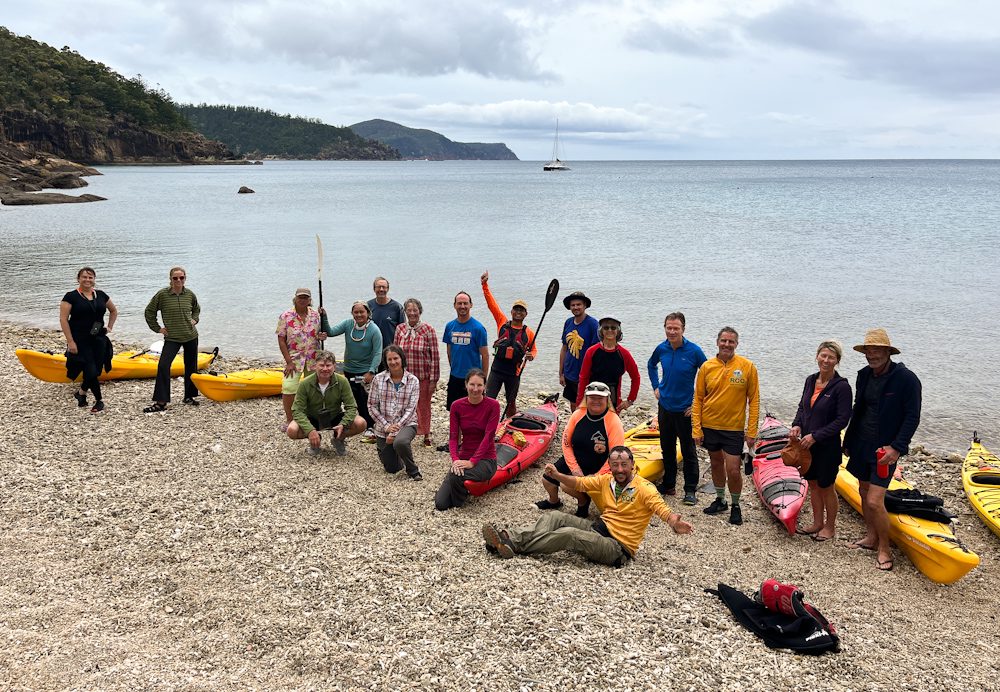Whitsundays Adventure Week
Whitsunday Islands
1-6 June 2022
Text and images kindly provided by many Club members and participants
With the start of the new paddling season in the Whitsunday Islands, Queensland, a much-anticipated Club paddling trip was finally able to hit the water. A six day adventure with nineteen Club members, amazing paddling conditions and much food and laughter along the way.
The trip was originally scheduled for September 2021—however COVID lockdown 2.0 and associated state border closures meant it simply wasn’t possible. Just part of life and we very quickly picked some new dates, allowing for an additional couple of days on the water. The timing ended up being near perfect, escaping the start of the chilly Sydney winter.
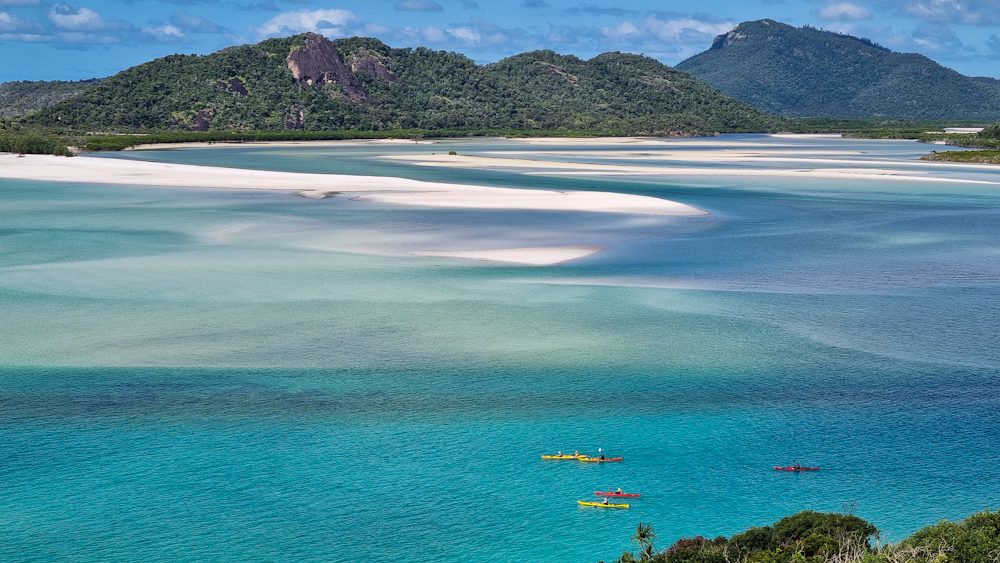
Crew members
We had nineteen Club members in total, from a wide range of different paddling backgrounds and experience levels. Some from an open water background, others more from whitewater paddling. It ranged between people who had paddled Bass Strait and others who never done an overnight trip before.
You ultimately couldn’t wish to have a nicer group of people to paddle and share a week-long adventure with. All incredibly supportive, encouraging, good humoured and happy to chip in, without attitude nor ego. Rather sadly, we had three paddlers needing to pull out in the final 48 hours before the trip, succumbing to the nasty flu that was circulating around Sydney.
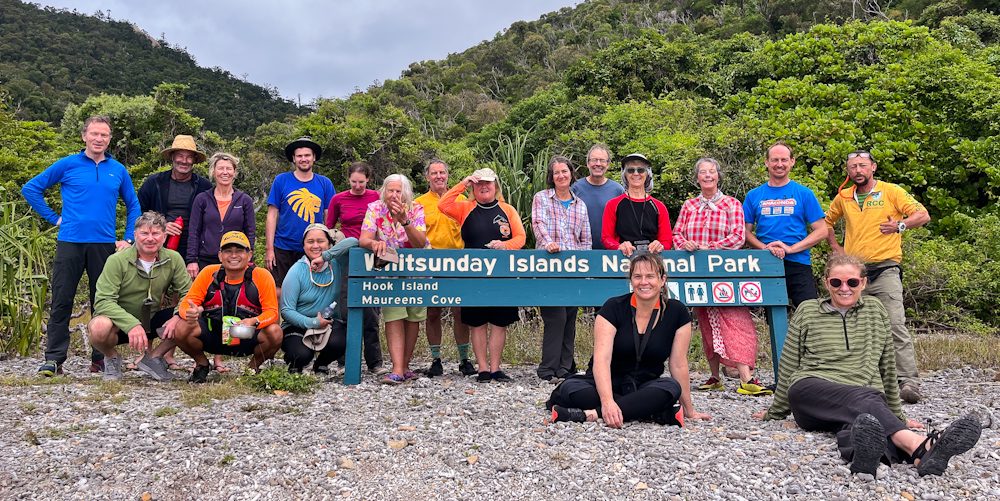
Trip planning
Despite the challenges of La Niña weather in early 2022, we managed to sneak in a couple of upskilling opportunities, including a fun few days down at Jervis Bay. The opportunity to extend the upskilling to include some in the broader Club community—not able to make the Whitsundays trip itself—was very well received.
With a number of Zoom trip planning sessions—and exhaustive use of WhatsApp messages and emails—it was great to be finally underway. After weeks of dehydrating food, then packing and unpacking dry bags to ensure we had what we needed—and could take it on a flight and then pack it in our rental kayaks—we finally could begin our adventure exploring the wilderness of the Whitsundays National Park.
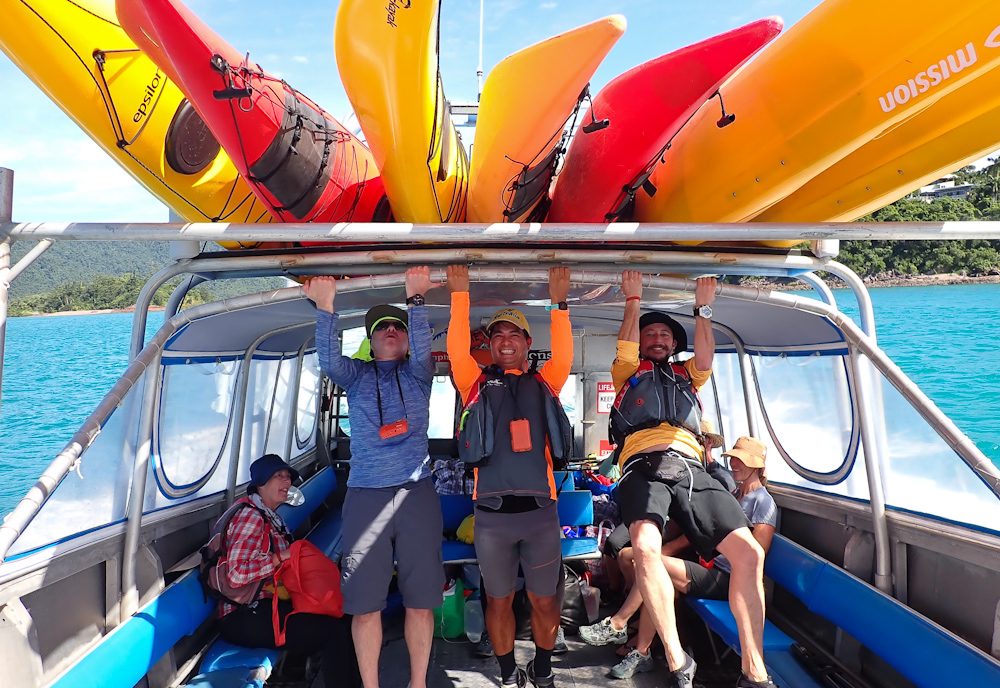
Itinerary
The first thing that struck us as we flew into Proserpine was the classic aqua Whitsundays colour of the water and the number of islands dotted about. What a holiday this was going to be!
DAY ONE
Scamper Water Taxi to Whitehaven Beach, then a blissful afternoon of snorkelling and paddling to the side of Haslewood Island. A rather nervous entrance into the water wearing head to toe stinger suits, flippers, face masks and snorkels, resembling robbers from The Grand Heist. Heads-down, bottoms-up and we entered a magic world of colour which is incomprehensible, nature at its very best. Spotted, stripy and technicolour fish jutting out from homes that matched their repertoire. It was indeed a visual feast.
DAY TWO
Paddled from Whitehaven Beach, up into and past the stunning Hill Inlet and on to campsites at Cairn and Curlew. Entry to Hill Inlet is a bit difficult to spot from the water due to shallow channels. Probably best explored with more time on a shorter paddle day—very spectacular to see from the lookout, and from up there you wonder how you could actually miss it. Our first jaunt camping on the beach—we spent the afternoon cooking on the beach, comparing dehydrated meals and chatting into the night.
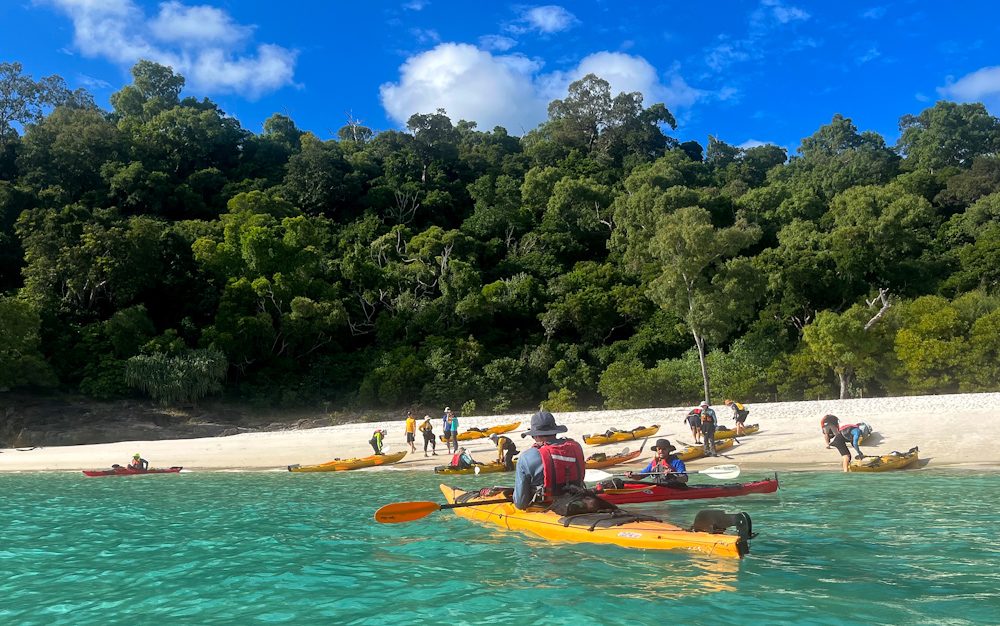
DAY THREE
Paddled down to Dugong Beach, with some starting the day with a challenging pre-sunrise hike up to Whitsunday Cairn before the paddle to see the sun rise over the ocean. An absolutely breathtaking scene as the sun rose, reflecting across the water and illuminating islands. The view was worth the challenge. An afternoon of relaxing and exploring nearby Sawmill Beach with four keen, energetic enthusiasts climbing to the summit of Whitsunday Peak and staying there until sunset, followed by a descent in part darkness. Freshwater rinse and dip areas are available near Sawmill Beach on the way up to the peak. Also, a drinking water drop also arrived for everyone at Dugong Beach. Some clever people organised other special drinks and treats. Everyone cooked up a storm—it was a happy night.
DAY FOUR
Paddled to Cairn and Curlew campsites, with the two groups swapping over. An afternoon of snorkelling and hiking up to the cairn or lazing on the beach at Curlew. Both great beaches, beautiful and so different.
DAY FIVE
Paddled through the Hook Passage, up the coast to Crayfish Bay for a few hours of snorkelling. Each snorkelling spot had a different array of colours, patterns and sea life. A highlight was a massive clam which was iridescent—it quickly closed as you floated over it. An afternoon on the water, paddling up past Pinnacle Point and around the top of Hook Island across to Maureens Cove. The scenes on this day were so impressive, wrapping around the coastline. We felt like explorers on an adventure where no-one had been before. The scale of our kayaks compared to the larger-than-life cliff faces was humbling. It felt like we were an insignificant speck in the whole grand scheme of things. Mother Nature at its very best—we paddled past in great awe.
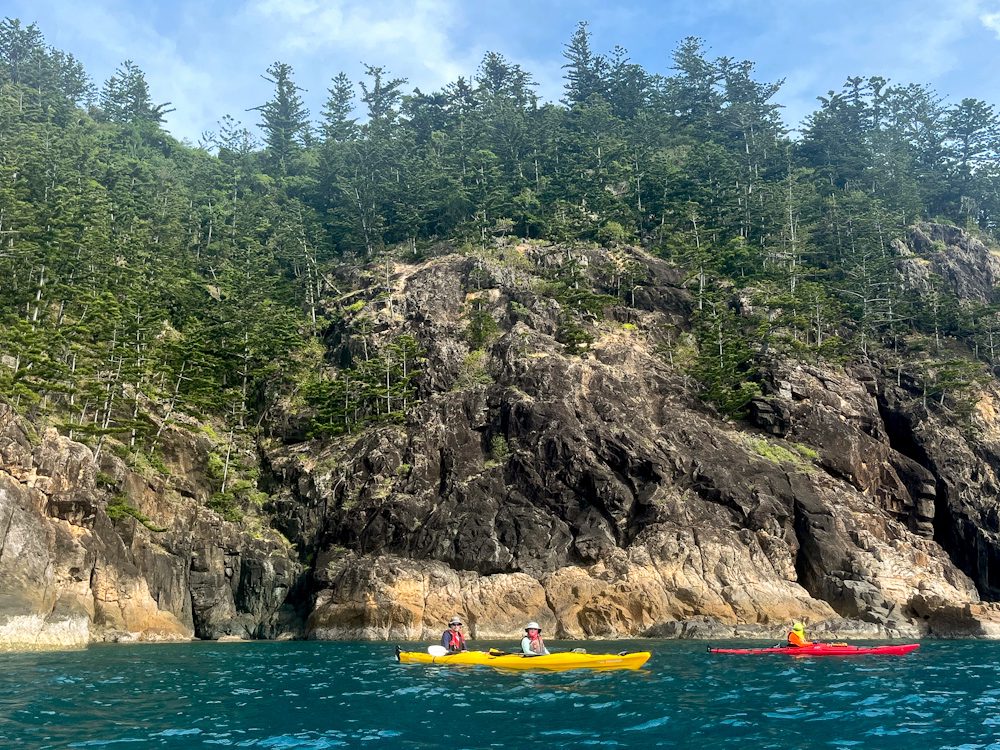
DAY SIX
Paddled around Butterfly Bay and over to Steens Beach before returning to Maureens Cove for water taxi pick-up—you’ve never seen an aluminium boat like this go so fast—and return back to the mainland for an evening out at The Deck restaurant, with some well deserved cold drinks and tasty (non-freeze dried) meals.
Paddling gear
We ended up hiring nine single sea kayaks and five double kayaks from Neil and Hayley at Salty Dog Kayaks—they were an absolute pleasure to work with. Only one minor maintenance repair required for the whole trip, which considering the marine environment was outstanding.
What were the boats? All plastic, some Prijon, some Boreal and others Eco Horizons. It worked out around $400 per person for boat hire, paddle, sprayskirt, sponge and hand pump for the six days—a relative bargain. We were also able to swap between boats to experience the different boat performances and virtues of paddling single or double. One aspect we found that really needed improvement was the hire sprayskirt waist sizes, which were typically too large and kept sliding down despite the velcro straps. Next time we should ask for a range of smaller waist sizes.
Single or double kayak? Most people assumed they wanted a single kayak, but many of us noticed that the doubles were often faster and easier paddling than the singles—and more fun to share the experience with another person. You had time to tell stories to each other paddler, talk about future plans, have one person paddle at times while the other took photos, and so on.

Whilst the weather was exceptionally good, it was still wise to have a light thermal top and a paddle jacket that sealed at the wrists—just in case. We could imagine the jacket at least could be needed in some weather conditions. A hat with chin strap that did not fold flat on your forehead in the wind, and sunglasses with headband was essential.
What was really noticeable was smaller-size dry gear bags are the best approach, especially for when you need to fit bags into smaller hatches and up the ends of a kayak. The best sizes seemed to be 4 litres up to 13 litres, though in the middle hatch of the double you could have a larger size—up to around 20 litres.
We had no shortage of group communications equipment, including a satellite phone, PLBs, Garmin InReach and InReach Mini, and three marine radios. Much of the time on the west side of an island a Telstra or Optus-based mobile phone worked reasonably but there were some issues with not sending photos and just sending text messages.

Travel and camping gear
Tents: We all used tents and concluded that having a self-standing inner was the best setup
Chairs: Mainly foldable ones that packed up small and had feet pads that stopped the chair sinking in the sand were best—though some claimed the alternative flat-seat pad type setup was arguably just as good.
Cooking stoves: These were a mix of gas, or metholated spirit powered, with one case of using fuel tablets. All seemed to cook the dinners or heat the water. Interestingly, no-one brought a pressurised Shellite-based stove.
Gear bags: There were some el-cheapo (two dollar type shop) gear bags but these needed support straps to stop them bursting apart at the zip though, with some bags tearing apart in transit. The better approach was the lightweight 100 litre duffel bag to carry it all as recommended by Kevin.
Personal items: Most personal stuff was progressively picked up by everybody in a small carry-on bag through the lead-up to the trip. We also noticed there is an Anaconda store at Airlie Beach, so you can get last-minute extras if needed—but you would need to ensure they had camping items in stock that you need.
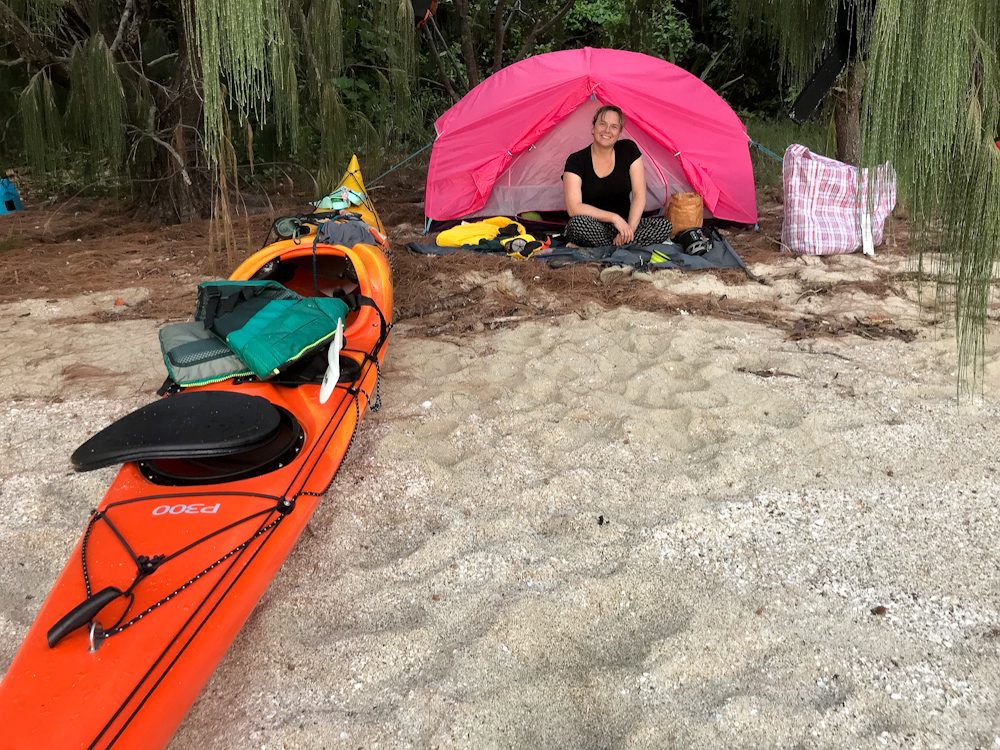
Sleeping bags: A good sleeping mat and small blow-up pillow definitely a must, particularly considering the coral features in the ground in some of the campgrounds. A lightweight sleeping bag provided plenty of warmth, considering the overnight temperature only went down to 17 degrees.Stinger suits: Some people used stinger suits for snorkelling—others did not use them for a swim. We were not sure if they were really needed or not at this time of year, but wearing them snorkelling gave a sense of reassurance.Safety: The gear we were happy to have—but even more happy not to use—included a satellite phone, personal locator beacons, first aid kits, most of our repair kits, and the Club trip defibrillator.
CampsitesAll sites had at least bush toilets, but toilet paper was definitely needed to be brought. At Cairn and Curlew there is no roof or door, so the toilet looks at the bush—it gives that open feeling when you need to go! We were not sure what the experience would be like if it was raining a lot.
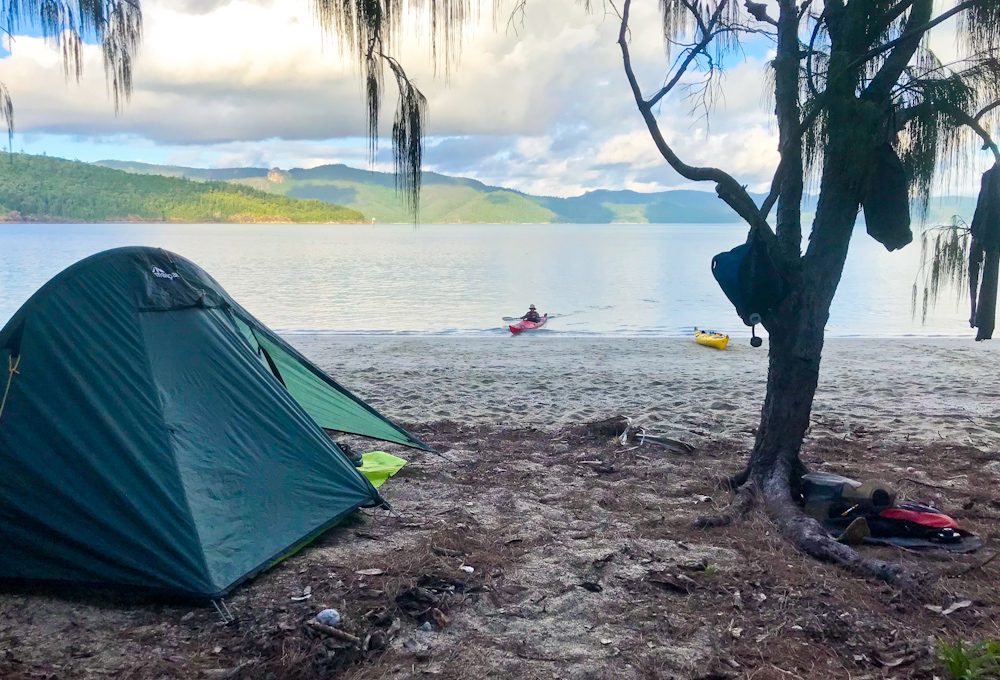
Food and drink
Let’s just say nobody went hungry and there was definitely a vast array. There is clearly scope for a River Canoe Club camping cookbook if anyone volunteers. Nam’s rum mix and jerky is legendary, along with the amount of food he brought. Also, Jo’s seeded crackers were impressive. No-one seemed to go short of wine or other spirits to drink!
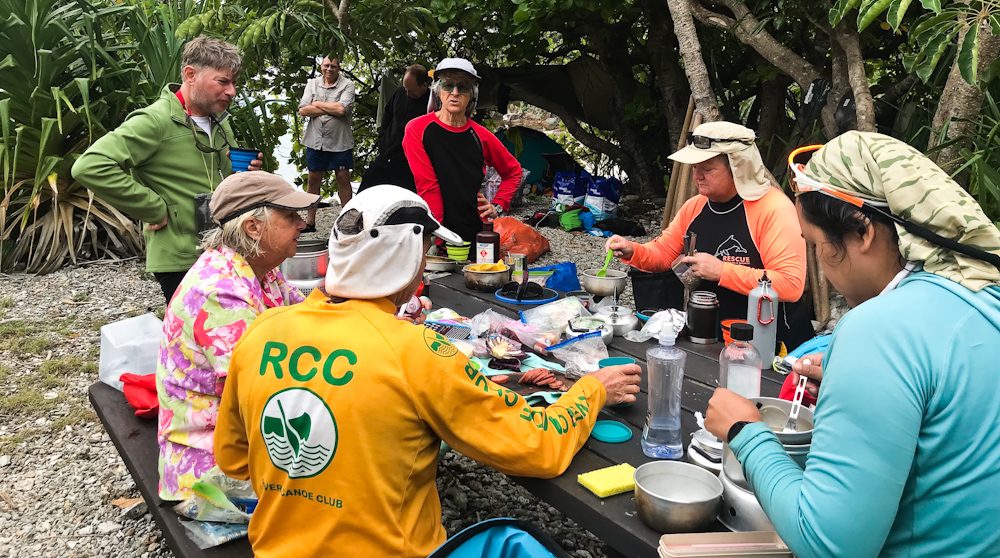
Paddling conditions
We were incredibly lucky with the temperatures, winds and tides—it was the best weather period in many weeks. Mark was once heard saying “It’s so calm, you get bigger waves in a swimming pool!” We were very lucky—most people planned on rain and swell, but it was clear every day and the swell was incredibly small. Winds were either really low, low, or low-moderate.
Hiking and snorkelling
We had plenty of opportunities for some great hikes, including:
- Whitehaven lookout and Chance Bay.
- Hill Inlet lookout with the hoards of tourists, but the view was well worth it.
- Whitsunday Cairn, for sunrise or at other times.
- Whitsunday Peak, for sunset.
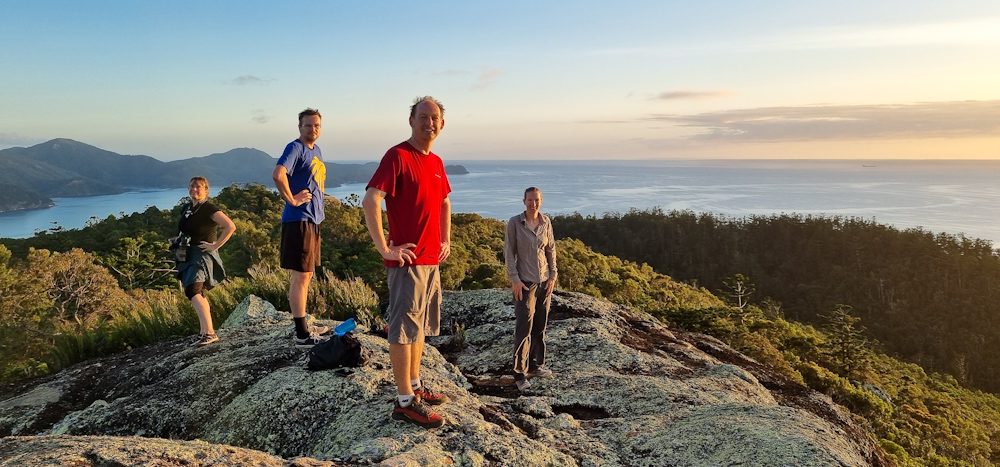
The best places to snorkel were:
- Maureens Cove: The snorkelling in Maureens Cove itself is a bit mediocre, but a short paddle to the east is Butterfly Bay, a popular tourist destination with many boats. Features large corals and clams, butterfly fish, parrottfish and damselfish in abundance. Quite a bit further is Steens Beach, which features quite a few offshore reefs.
- Crayfish Bay, both from the main beach (north facing) and secondary beach (eastern facing). A great place to spend two days to snorkel. Also a great place to float (carefully) in the kayak above or next to the coral—beautiful even from the kayak.
- Cairn Beach: Just off the beach there is a line of coral that is quite pretty. However, because of the current, you need to snorkel at low (slack tide)—then everything is clear.
- Curlew Beach: Paddle just around the southern tip of Macona Inlet and there are three little coves. The central or eastern cove is a bit nicer than the western one. The beach is very rocky and slippery, so be careful.
- Whitehaven Beach: Just paddle about two kilometres to the northern tip of Haslewood Island. Nice snorkelling.Don’t bother to snorkel at Dugong Beach—it is murky and there are sharks.
Funny moments
Some lighter moments from a great week:
- Learning that whales often sleep vertically.
- Turtles versus turdles.
- The wrong way to put on a stinger suit.
- How to get a beer from a stinkboat.
- How to get a six-pack from a luxury yacht.
- How to scare the #### out of someone at Cid Harbour.
- Drop toilet spiders.
- Lynn paddled like she was on a mission (name of the kayak).
- Jo being suspected of lobster smuggling on the flight home, having offered to take one of Nam’s bags. A perfect reminder of why one should always pack one’s own bag when travelling!
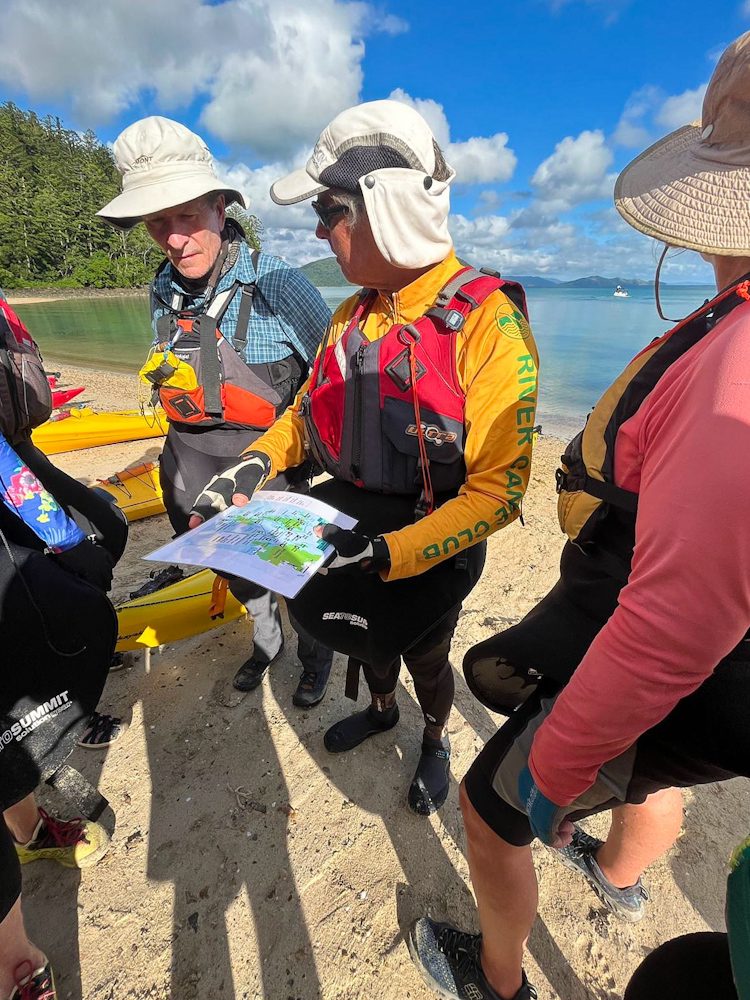
Reflections on the trip
In hindsight, it might have been nice to have been able to spend multiple nights in one camp along the way—a good thought for the future, especially where there is good access to walks and snorkelling as well as paddles.
Splitting into two groups, meeting up along the way, worked well. Maintaining radio contact was an important part of the equation. We thought the smaller group sizes worked well—maybe a max of 8 to 9 people and attempt to match paddle speed.
First aid kits—check them before you go.
A tough groundsheet or two is essential when camping on the coral ground to protect the tent floor and mattress.
More fresh food instead of hydrated meals—but if it was hot the fresh food may not last long.
Expect to have to make minor repairs to kayaks and allow extra time for daily adjustments to kayak setup if changing boats each day. Taking your own seat pad is a good value item.
It was very useful to have annotated pictures of packing for the trip to give an idea of gear and weight.
Take your own paddle leash—especially if windy conditions are expected.
Dugong Beach in Cid Harbour is no longer recommended for swimming, due to sharks.
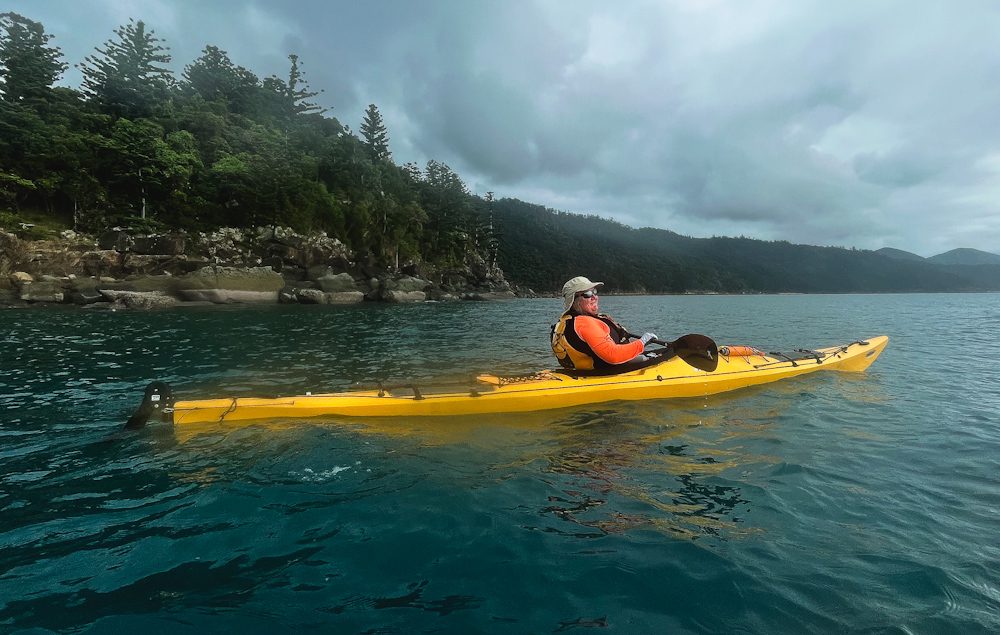
Paddling around the north-east corner of Hook Island has the potential to be lumpy. We paddled through in relatively benign conditions, but not sure you’d want to be there when either swell and/or wind was kicking in.
Daryl from Airlie Beach Party Bus did an amazing job of shuttling the crew around, wherever needed to get to when on the mainland. It’s approximately a ten minute transit from Shute Harbour to The Big4 Eco campground, and in turn similar again back into Airlie Beach.
Some biting insects in the evenings—mosquitoes and midges. Bushman’s Spray was needed, as well as covering up with enclosed footwear. (Both were important though covering up was the priority.)
What to do better next time
Much of this area is out of mobile contact. The initial impression of this is “Great—I get a relief from constant email and phone calls”. However, this has the downside that it is difficult to figure out where you are—even if you are carrying laminated paper maps. We are so used to having 4G/5G-delivered Google Maps that we have forgotten that when we are out of mobile coverage, Google Maps disappears also.
The solution to this is for a few people to either (a) download the islands in offline Google Maps or (b) get a GPS application on your mobile that supports offline maps, or (c) get a GPS device. Only one person had downloaded the offline Google Maps and laminated them as well as the broad-scale map and so was able to confirm where we were located with respect to the paper maps and campsites.
Maybe next time there should be more encouragement to do something similar so there is at least a set of similar maps with each group. Michael did a great job of providing copies of laminated detail boating maps which significantly helped with the navigation and locations.
What to absolutely do: the laminated detailed maps were used a lot. Don’t forget these but also have the broader scale map.
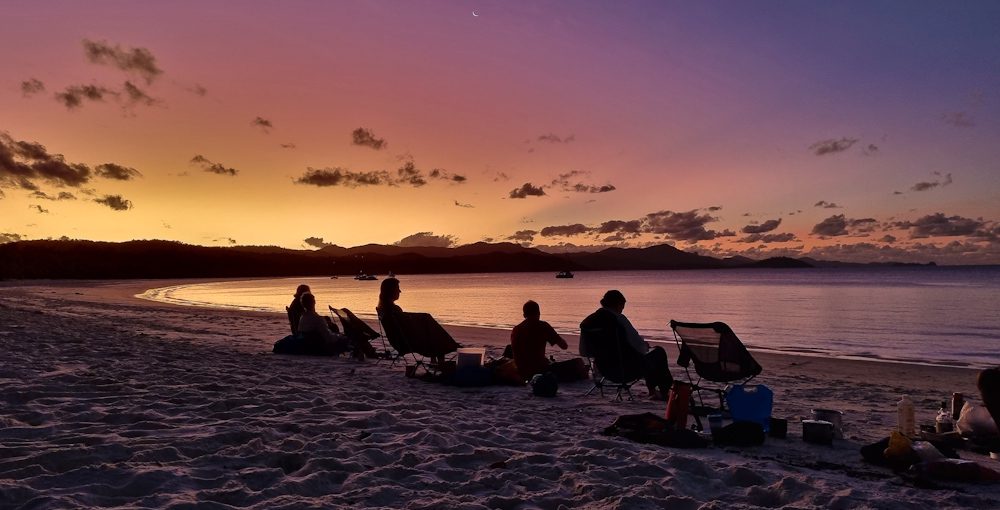
Final thoughts
Would it be a considered a family-friendly trip? Probably not in the format we did it, due to some extended periods and distances in the kayaks. That said, it wouldn’t be difficult to come up with a family-friendly itinerary.
To be done again? Absolutely. If we do this again, perhaps consider staying in one location for two nights and taking day trips. The continual tent set up and tear down and packing and unpacking was a bit exhausting for some people.
Other destinations. The trip also inspired discussions as to other destinations for future Club trips to Queensland, such Hinchinbrook Island. Also discussed were destinations further afield, including Tasmania, as well as plenty of great possibilities in the South Pacific, including the Cook Islands, Fiji, Tonga and Samoa.
